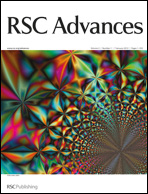In this work, a simple hydrothermal method is presented for fabricating hierarchically porous silica nanocubes using a surfactant-polyelectrolyte template. The formed silica nanocubes possess Pm![[3 with combining macron]](https://www.rsc.org/images/entities/char_0033_0304.gif) n symmetry, which are patterned after organic template and their shape can be easily transformed from solid nanocubes to hollow cubes by controlling the composition of the surfactant-polyelectrolyte template. We have studied the fabrication conditions of silica nanocubes as a function of reaction temperature, reaction time, and the amount of reactants, and proposed a nanoparticle formation mechanism. For drug delivery, the calcined solid and hollow silica nanocubes show high loading capacities of ibuprofen, 362 mg g−1 and 509 mg g−1, respectively. These properties make the hierarchically porous silica nanocubes a promising material for drug delivery.
n symmetry, which are patterned after organic template and their shape can be easily transformed from solid nanocubes to hollow cubes by controlling the composition of the surfactant-polyelectrolyte template. We have studied the fabrication conditions of silica nanocubes as a function of reaction temperature, reaction time, and the amount of reactants, and proposed a nanoparticle formation mechanism. For drug delivery, the calcined solid and hollow silica nanocubes show high loading capacities of ibuprofen, 362 mg g−1 and 509 mg g−1, respectively. These properties make the hierarchically porous silica nanocubes a promising material for drug delivery.
You have access to this article
 Please wait while we load your content...
Something went wrong. Try again?
Please wait while we load your content...
Something went wrong. Try again?
![[3 with combining macron]](https://www.rsc.org/images/entities/char_0033_0304.gif) n symmetry, which are patterned after organic template and their shape can be easily transformed from solid nanocubes to hollow cubes by controlling the composition of the
n symmetry, which are patterned after organic template and their shape can be easily transformed from solid nanocubes to hollow cubes by controlling the composition of the 

 Please wait while we load your content...
Please wait while we load your content...